
Shampoo Bar: Butter Bar Conditioner
- Out Of Stock
Dry hair develops when your hair does not get or retain enough moisture. Since the hair itself has no natural lubrication it relies on the natural sebum (oils) made by the scalp to keep it shiny and moisturized.

Sebum fills the gaps between the protective cuticle cells to keep hair shiny and flexible. Unfortunately, sebum also causes dirt and pollutants stick to your hair. As you shampoo your hair to wash away the dirt, the protective oil goes with it.
Sometimes, the scalp does not make enough oil, which leads to dry hair. Also, as you age, your hair naturally makes less oil.
Dry hair can also be the result of damage to the protective cuticle layer. Just as shingles shield your home from rain and sun damage, the cuticle shields your hair from heat and sun damage.
In a healthy cuticle, the layers lie tightly together which helps retain moisture. When there is damage to the cuticle, layers can separate from the hair shaft and impair its ability to hold moisture.
Dry hair lacks the hydration it needs to give it a sheen and a soft texture. As a result, hair that is dry will often be brittle and dull, have a straw-like texture and appear frizzy, lifeless, and dull.









Lack of moisture causes hair to loose bounce, luster and shine, and look dull and lackluster
Dry hair, more brittle and less elastic than normal hair, is more prone to breakage. Did you ever try to use an old rubber band that had dried out? As soon as you stretched it--it broke. Dry brittle hair behaves the same way--the less give (elasticity) your hair has the less moisture it contains and the more easily it breaks.
Does your hair feel like silk or like straw? Dry hair has a rough and coarse-to-the-touch texture. Dry hair is often frizzy or has lots of fly-away strands.
When the skin on your body is dry, it is often itchy and flaky. The skin on your head, your scalp, is no different.
When the end of a hair strand separates into two or more pieces--you have split ends. Most agree that there is no way to fix split ends. The best solution is a good trim. But you can help prevent them by being more gentle with your hair and adding a good natural conditioning balm to the ends. There are many folks with split ends that do not have dry hair!
Dry, frizzy hair is dull, lackluster and usually characterized by a feeling of dryness, split ends or hair that is brittle and breaks easily. This type of hair feels rough, and not smooth and silky and is generally indicated by frizziness, fly away hair and a lack of shine. Dryness can be caused by insufficient oil production by the sebaceous glands on the scalp or due to hormonal imbalances, diets deficient in proteins and vitamins or due to chemical treatments.
Coarse hair has thick, large hair strands. Although, coarse hair is not a symptom of dry hair, for many coarse hair is often dry, brittle and rough. Without proper moisture coarse hair tends to be more dry, frizzy, and stubborn than other hair types.
Using a small amount of a warm oil or balm (even just warmed between your hands) helps the moisture penetrate the strands rather than sitting on top.
 The path to beautiful hair begins with natural cleansing and all shampoos are not created equal!
The path to beautiful hair begins with natural cleansing and all shampoos are not created equal!
Use a moisturizing natural shampoo made with organic ingredients that will gently clean the hair and scalp without stripping away all the natural protective oils.
Commercial shampoos are made using detergent cleansers, synthetic preservatives and stabilizers, and other additives that can be harsh on the hair and scalp. In order to compensate for the stripped natural oils, you reach for the bottle of conditioner.
Commercial conditioners often coat the hair and weigh it down.
Natural shampoo bars contain carefully selected ingredients that promote a moisturized scalp and well-conditioned hair.
Learn More Blog, Everything You Want To Know About Shampoo Bars
 If your hair is dry or damaged, you can help replace missing oils by using natural, organic hair balms and hair oils that nourish hair, seal in moisture, and keep hair hydrated and healthy.
If your hair is dry or damaged, you can help replace missing oils by using natural, organic hair balms and hair oils that nourish hair, seal in moisture, and keep hair hydrated and healthy.
Moisturize Daily: If your hair is very dry, use hair balms or oils daily to help decrease split ends, stop frizz, and add shine back to dull, lifeless hair.
After shampooing place a tiny amount of oil or balm in the palm of your hand, rub palms together and smooth over the length of your hair (wet or dry) evenly. Then comb hair thoroughly to get the oil evenly distributed. Or apply to just the dry ends.
Learn More: How To Use A Conditioning Hair Butter Balm
Learn More: How to Use a Hair Oil for Shiny Healthy Hair
Scalp massage, with or without moisturizers, can help stimulate blood flow and natural oil production. (Read more about scalp massage below)
 Shampoo less often: Even using a gentle shampoo can be drying if done too often. If your scalp starts looking a bit oily, a natural dry shampoo can help by absorbing excess oils on the scalp.
Shampoo less often: Even using a gentle shampoo can be drying if done too often. If your scalp starts looking a bit oily, a natural dry shampoo can help by absorbing excess oils on the scalp.
Let your hair air dry: Keep blow dryers and other heated styling tools to a minimum. It may take a few weeks for your natural shine and texture to show through. If you must use heated tools once in a while, use the warm or cool settings.
Be Gentle: Dry hair is fragile hair. When shampooing, do not scrub or wring hair and use a lukewarm water rinse. Hot water can be damaging to dry hair.
Use a comb instead of a brush: Brushing hair rips through snarls and can leave your hair looking frizzy and rough. Use a wide-toothed comb while hair is wet for gentle detangling.
Stop chemical hair treatments. Chemical treatments, like dyes, perms, and relaxers, even if done once, can cause long-term damage. Use natural hair balms or oils with hydrating properties.
Scalp massage can improve scalp circulation and encourage natural sebum production in dry hair.
You can massage a dry or wet scalp. An easy way to incorporate a scalp massage into your hair care routine is in the shower after applying shampoo or conditioner. Or do a scalp massage in the evening before bedtime since it can also help ease stress and tension.
Spread your fingers, and then place your fingertips on the scalp. Avoid using fingernails which can break hair strands or damage the scalp. Use slow, gentle movements to move your fingertips in a circular pattern around the whole head, alternating fingertips around different areas of the scalp.
You can do a gentle scalp massage as often as you would like.
If your scalp is very dry, add a few drops of natural hair oil to your fingertips before massaging the scalp.
A flakey scalp does not always mean dandruff. It could be an indication that the scalp is very dry and/or irritated. Proper brushing can help "exfoliate" the scalp to remove dead skin cells and allow natural oils to nourish the scalp. This is great to do before shampooing.
Your Natural Scalp Oil may hold the key to beautiful hair. Brushing can help stimulate the scalp and distribute natural hair oils, which adds shine to your strands.
Be gentle, and do not brush hair when wet or tangled to prevent breakage.
Depending on your hair type proper hair brushing, sometimes called "dry brushing" can help condition your hair. If the hair is free from knots and snarls, use full gentle strokes from the scalp to the tips to help to distribute the natural hair oils.
If the hair has knots and snarls then if you start at the scalp and pull hair down to the ends it can result in hair breakage. Begin a few inches from the bottom and slowly work your way up the strand in small sections and short strokes to remove hair tangles. You may want to use a wide toothed comb for this part. Then you can brush from the scalp to the tips to help to distribute the natural hair oils.
If you have very curly, coarse or coiled kinky hair, brushing will more easily damage the cuticle and often causes breakages. Instead use your fingers to do a scalp massage and then distribute natural oils along the hair length.
Not all hairbrushes are created equal. Do research on the internet to find the best brush for your hair type.









The wholesome goodness of our handcrafted soap is available for your hair.
Shampoo bars are an all natural conditioning shampoo in a solid bar form. Yes, this is real shampoo in a solid bar. Shampoo bars are not a new idea.
They were commonly used before liquid detergent shampoos and conditions were invented in the 1940s.
Although the process for making a shampoo bar is the same as making soap, our shampoo bar "recipes" are specially formulated with natural plant oils, butters, botanicals and essential oils that nourish your hair and scalp.
Our shampoo bars contain no artificial fragrance, color, preservatives, detergents, alcohol, urea, formaldehyde, sodium lauryl sulfate, DEA, propylene glycol - or any of the other synthetic hair care additives.
Each of our shampoo bar selections contains a different blend of natural plant oils, essential oils, and herb infused oils. No two recipes are the same.
Click here for help choosing an all natural shampoo bar!
Please read "Everything About Shampoo Bars!"
Some folks do, and some don't!
If you are using a conditioner because your hair is dull, lacks luster, and is dry--you may not need a conditioner--that's another plastic bottle saved! Since commercial shampoos contain petroleum products that are actually drying to your hair and scalp, conditioners are usually needed.
Our natural shampoo bars will not strip the natural oils from your hair, so you will not need the typical moisturizing conditioners that people use to replace the natural oils stripped by detergent shampoos.
Apple Cider Vinegar (ACV) rinses are an excellent addition to any natural hair care routine and can help bring back body and shine to dull, lackluster hair.

Hair tangles result when individual hairs go in different directions and intertwine.
The outer layer of the hair, the cuticle, is made of overlapping layers of long scales that lie along the surface of the hair like shingles on a roof.
The condition of the cuticle scales in part determines whether you are going to have tangly hair. When you shampoo or even wet your hair, the cuticle opens making it prone to tangling.
The way you shampoo and your hair type can affect hair tangles. I have long, fine, thin hair that is very prone to tangling. Just imagine all of those little strands of hair as very thin strings—now put little burrs on the strings (the open cuticle) and you can see my problem.
When I used a commercial shampoo I would go through a 16-ounce bottle of conditioner every week—just to get a comb through my hair. Using my shampoo bars has made a big difference.
I wish I could use an apple cider vinegar (ACV) rinse every day. Besides creating tangle-free locks, I also love the way it makes my hair look and feel. As I have gotten older, my hair has become dryer and I can only use a traditional ACV rinse 2 or 3 times per week. But I keep a spray bottle of very dilute ACV rinse that I use more often.
Helpful hint: If I comb through my hair length while it is still lathered and continue to comb as I rinse, the tangles comb out more easily.
Some customers have reported that they needed to continue using their traditional conditioner for a while and then were able to slowly wean off of it. I say, whatever works for you!
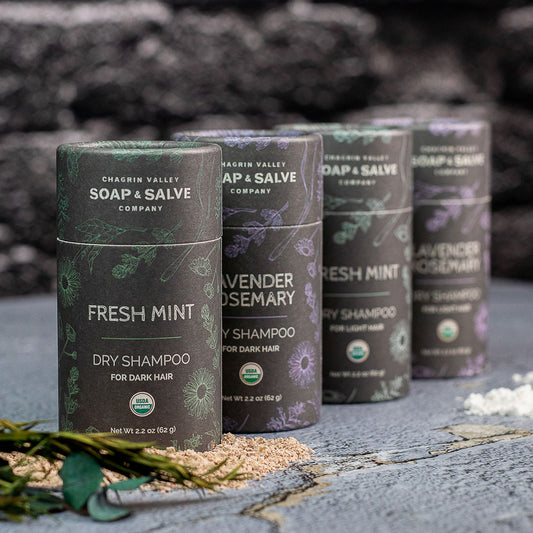
What is a Dry Shampoo? How Does Dry Shampoo Work? How Do You Use a Dry Shampoo? Are All Dry Shampoos the Same? In this blog, I hope to answer all of your dry shampoo questions!
Read Post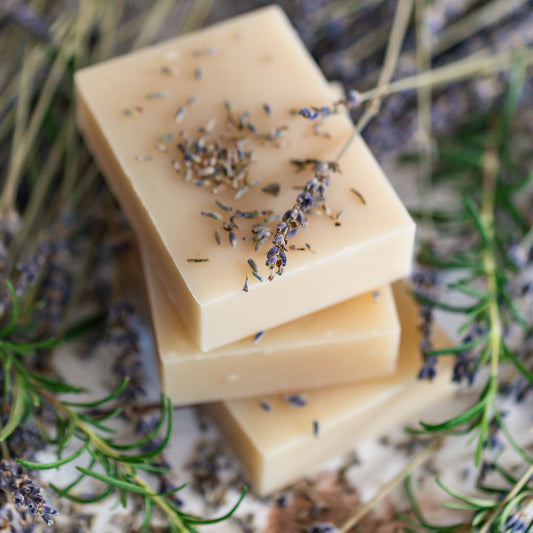
Explore the world of natural shampoo bars, get answers to your FAQs and learn about the benefits, ingredients, hair type suitability, and usage tips. Start enjoying healthier, happier hair.
Read Post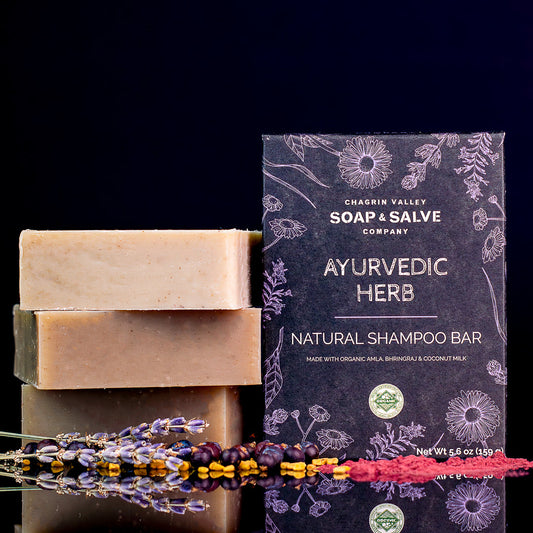
Eco-friendly natural shampoo bars, formulated with no synthetic detergents or foam boosters, no synthetic fragrances or colors, and no preservatives, contain only the ingredients they need.
Read Post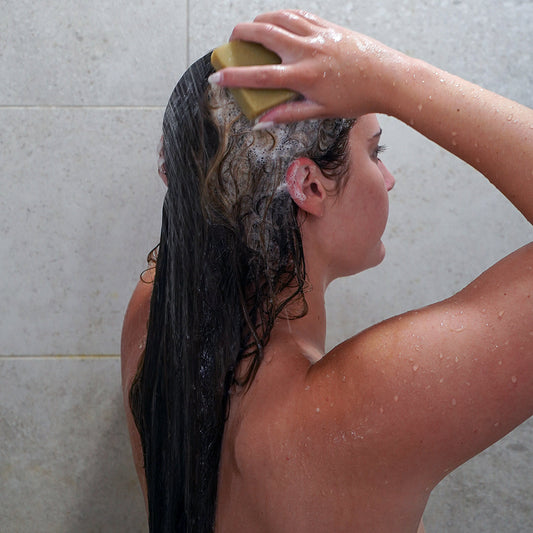
While finding the right shampoo bar is important, using the proper technique to wash your hair is the best way to ensure a successful transition from synthetic shampoo to natural shampoo bars.
Read Post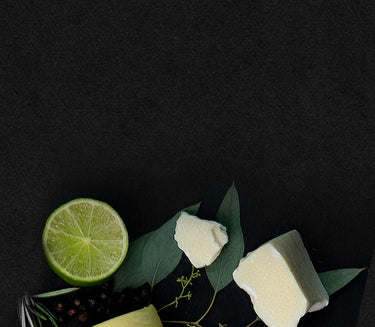

People with severe allergies—please note: If you have severe anaphylactic-type reactions to ANY of the ingredients in ANY of our products, please do not buy our products. We have dedicated soap rooms and product rooms that are kept meticulously clean, but we cannot guarantee against possible cross-contamination of individual ingredients.
Chagrin Valley Soap & Craft is not responsible for any individual reaction to any particular ingredient. Each product description on our website includes a complete list of ingredients. People with sensitivities to any listed ingredient should not use the product. In case you are in doubt always try an allergy patch test and if at any time irritation occurs, discontinue use of the product.
The content and information on this website, provided by The Chagrin Valley Soap & Salve Company, is for educational purposes only and is in no way intended and should not be construed as medical advice to diagnose, treat, cure, or prevent any disease or health condition. The information regarding folklore or health-related benefits of certain ingredients is for educational purposes only. The information provided is not intended to prescribe or be taken as medical advice.
The information provided is not meant to substitute the advice provided by your personal physician or other medical professionals. Do not use the information found on this website to self-diagnose any medical conditions or treat any health problems or diseases. If you have medical concerns regarding yourself or your family you should seek the advice of qualified, licensed health professionals. Never disregard professional medical advice or delay in seeking it because of something you have read on this website.
This information has not been evaluated by the Food and Drug Administration. This notice is required by the Federal Food, Drug and Cosmetic Act.
Read our Full Medical Disclaimer.